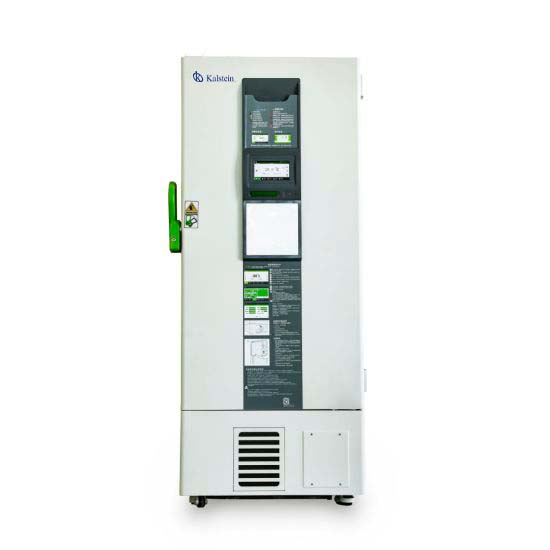A laboratory refrigerator is a specialized equipment of great relevance and very useful in these places, because its main objective is to generate a controlled environment (refrigerated space), where the fluids, substances, and reagents used in the laboratory, can be stored in optimal conditions. The functions, options and temperature ranges will vary depending on brands and models, there are several models of refrigerators for laboratories and each of them are of utmost importance, because thanks to the use of these effective equipment it is possible to properly conserve substances as reagents, and also biological substances, which, being well preserved, will generate analyzes with the expected results.
The lower the temperature, the lower the chemical and biological activity, and to achieve this requires that the temperature inside the refrigerator is lower than the room temperature. Refrigerators that also have a freezer have at least two separate compartments: one that functions as a freezer (with a temperature below 0 degrees) and one as a refrigerator (with a temperature above 0 degrees).
How should a laboratory refrigerator be used?
Through the use of laboratory refrigerators, the tests and determinations carried out in these places, achieve appropriate and correct results and objectives. Since these equipment is responsible for the efficient storage of all substances refrigerated in it, whether solid, liquid or homogeneous. Situation that constitutes the refrigerators in equipment of first necessity in a laboratory.
Therefore, it is required that laboratory personnel know well at what temperature they need to store each of the substances they use routinely. And therefore you must know how laboratory refrigerators work, in order to make proper use of them.
Types of laboratory refrigerators
A laboratory uses several types of refrigerators that could be grouped according to the types of substances to be stored and their uses:
- Clinical laboratory refrigerators: commonly used for sample and reagent storage. Laboratory refrigerators maintain a constant temperature to minimize the risk of cross-contamination or explosion of volatile materials. In order to maintain a stable and uniform temperature, many of these refrigerators have a fan that circulates air inside the equipment. They can also be used to conserve blood and vaccines. Although there are fridges that have the specific function of storing and preserving blood, and are known as blood bank fridges. They are used both in laboratories and in blood banks.
- Pharmaceutical laboratory refrigerators: are equipment designed for refrigeration and storage of medicines and vaccines under optimal conditions that ensure their preservation. These fridges operate providing reliable cooling and a stable temperature, and have an alarm system that is activated in case of power failure or if the refrigerator door remains open. This system is essential to avoid situations that may lead to increased temperature inside the appliance (especially in summer). It also has a safety system that prevents the temperature from falling below 0°C. Refrigerators intended for the storage of sensitive medicinal products are usually equipped with a closure system to control access to them.
What are the main features of a laboratory refrigerator?
It is of the utmost importance that the laboratory staff is well acquainted with the characteristics of a laboratory refrigerator. You should be familiar with its parts, its components and its operation. Among the main parts of a laboratory refrigerator, we have:
- Storage cabinet: Substances or samples are placed in this cabinet. In almost all laboratory refrigerator models, the storage cabinet is located under the evaporator. It is in this cabinet that substances and samples can be stored at “special” temperatures. Or different to the overall temperature of the refrigerator, and in turn this cabinet allows to place shelves to store such substances or samples.
- Evaporator : It is the heat exchanger device where the transfer of thermal energy from a medium to be cooled to the refrigerant fluid circulating inside the device occurs. The evaporator is located on top of the refrigerator cabinet (in some models it may vary). In order to determine whether the refrigerator is in use, the evaporator must be at a temperature below 0°C, although it can reach temperatures from 5°C to 30°C.
- Thermostat: It is the one that allows to control the cooling system and the temperature of the refrigerator.
What does Kalstein offer you?
Kalstein is a manufacturer of medical and laboratory equipment of the highest quality and the best technology at the best PRICES in the market, so you can make your PURCHASE confidently with us, knowing that you have the service and advice of a company specialized in the field and committed to provide you with safe, economical and effective options to perform your functions in the right way.
This time we present you our Pharmacy Lab Refrigerator of Medical Cryogenic Vaccine Equipment YR05289. The 2~8℃ pharmacy refrigerator is widely used in pharmacies and hospital laboratories. This is to place and preserve storage such as drugs, vaccines, enzymes, hormones, stem cells, extracted RNA and libraries of genes and important biological and chemical reagents. Equipped with a complete temperature alarm system with audible buzzer and visible flashing light capable of warning failures due to high and low temperature sensor errors, door half open, power failure and low battery
For more information we invite you to take a look at: HERE

